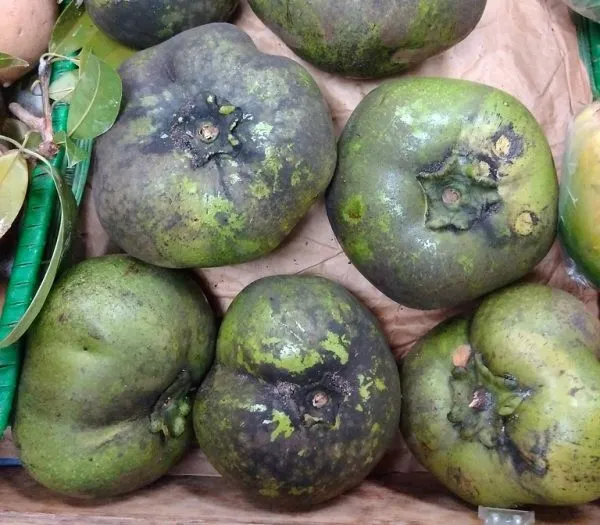
Imagine biting into a fruit that tastes just like chocolate pudding! The Black Sapote (Diospyros digyna), also known as the “chocolate pudding fruit,” is a unique tropical fruit that has gained popularity among fruit enthusiasts and home gardeners. This exotic fruit not only offers a natural chocolate flavor but is also packed with essential nutrients.
In this article, we will discuss the health benefits of black sapote, how to plant and grow it successfully in the Philippines, and where to buy this incredible fruit or its seeds.
What is Black Sapote?
Black sapote belongs to the persimmon family and originates from Mexico and Central America. Unlike traditional sapotes like mamey or white sapote, black sapote is famous for its dark, pudding-like flesh that resembles melted chocolate.
Taste and Texture
Ripe black sapote has a soft, creamy texture and a flavor profile reminiscent of rich chocolate mousse. While it lacks the bitterness of cocoa, it serves as a natural, healthy alternative for chocolate lovers.
Nutritional Benefits
Black sapote is not only delicious but also highly nutritious:
- Rich in Vitamin C: Supports immune function and skin health.
- Low in Fat: Unlike actual chocolate, black sapote is a low-fat alternative.
- Good Source of Fiber: Aids digestion and promotes gut health.
- Natural Energy Booster: Contains potassium and iron to support stamina and overall well-being.
How to Grow Black Sapote in the Philippines
Growing black sapote is relatively easy in the tropical climate of the Philippines. Here’s a step-by-step guide:
1. Choosing the Right Climate
Black sapote thrives in warm, humid environments. The Philippines’ tropical climate with its wet and dry seasons is ideal for growing this fruit. Ensure your planting area has good sunlight exposure and is protected from strong typhoons.
2. Selecting a Planting Method
Black sapote can be grown from seeds, grafted plants, or cuttings:
- Seeds: Takes longer to mature (5-7 years before fruiting).
- Grafted Trees: Begin fruiting within 3-4 years and ensure quality fruit.
- Cuttings: A faster alternative but requires proper care.
3. Ideal Soil Conditions
- Well-draining, loamy soil with pH levels between 6.5-7.5.
- Avoid waterlogged conditions, as excessive moisture can cause root rot.
- In provinces with clay-heavy soil, mix in sand and organic matter for better drainage.
4. Planting Process
- Dig a hole twice the size of the root ball.
- Mix compost with the native soil to enhance fertility.
- Plant the tree and ensure the graft union (if present) remains above soil level.
- Water thoroughly after planting.
5. Watering and Fertilization
- Water deeply but allow the soil to dry slightly between waterings, especially during the dry season.
- Use organic fertilizers like vermicast, aged manure, or fermented plant juice (FPJ) commonly used in Philippine organic farming.
- Apply mulch around the base to retain moisture and regulate temperature.
6. Pruning and Maintenance
- Prune annually to shape the tree and remove weak branches.
- Protect from pests like aphids, mealybugs, and fruit flies using neem oil or homemade organic insecticides.
- Monitor for diseases like anthracnose and apply preventive fungicides if necessary.
Where to Buy Black Sapote Trees, Seeds, and Fruits in the Philippines
Finding black sapote can be challenging, but here are some reliable sources in the Philippines:
1. Local Plant Nurseries and Agricultural Stores
Many garden centers and nurseries in provinces like Laguna, Batangas, and Davao offer black sapote seedlings.
2. Online Marketplaces
Several online platforms sell black sapote seeds, saplings, and fruit, including:
- Lazada & Shopee – Reliable for purchasing seeds and young plants from Philippine sellers.
- Facebook Marketplace & Groups – Many Filipino plant enthusiasts and farmers sell sapote seedlings.
- Agri-based Websites – Look for specialty fruit tree sellers in the Philippines.
3. Public Markets and Specialty Farms
Some wet markets and organic farms in Quezon, Cebu, and Davao occasionally sell black sapote fruit, especially during peak seasons.
4. Fruit Farms and Agritourism Sites
Some farms allow you to order black sapote fruit directly or visit and pick fresh fruits. Check out farms in Bukidnon, Negros Occidental, and Mindanao known for their tropical fruit production.
Final Thoughts
Black sapote is an extraordinary fruit that offers a guilt-free chocolate experience. Whether you’re a gardening enthusiast or a health-conscious foodie, growing your own chocolate pudding fruit in the Philippines can be a rewarding experience.
By following the right planting techniques and sourcing high-quality seeds or trees, you can enjoy this exotic delight right from your backyard. Ready to start growing? Find your perfect black sapote plant today and indulge in nature’s chocolate substitute!

